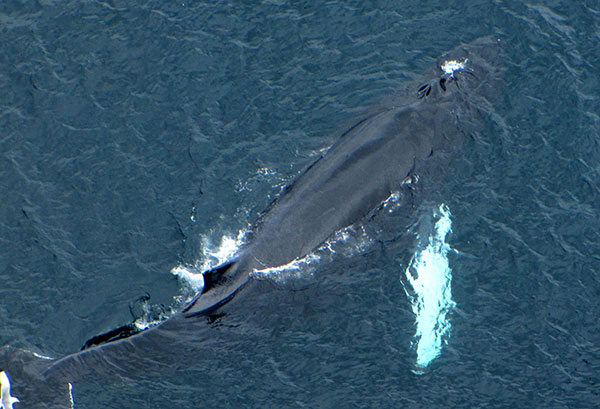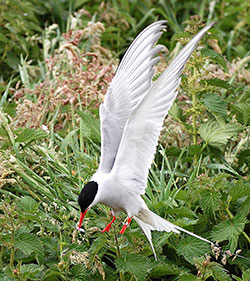
A humpback whale is seen on the surface of the ocean.
THE word ‘commute’ entered the English language in the mid-17th century, when it simply meant to exchange. Today commuters daily exchange their homes and workplaces. This is associated, normally, with the daily movement of suburban and rural dwellers into a city or town early in the morning to return to their abodes in the evening. This is a form of lateral migration with inevitable traffic jams and congestion.
Vertical migration
This form of migration takes place in our oceans on a daily basis. At night the oceans experience the greatest mass movement of organisms on our planet. By day, phytoplankton rely on sunlight for photosynthesis, thus lie near the sea surface.
Zooplankton that feed on phytoplankton lie very much deeper in the sea. At night, the zooplankton surge upwards towards the surface to feed.
Other marine creatures, from deeper in the ocean, shadow the movement upwards of the zooplankton. When dawn breaks there is a vertical downwards migration.
The leatherback turtle spends much of its day in diving down to depths of 600 metres or more to observe colonies of jellyfish.
At night as the jellyfish migrate upwards towards the surface to feed on zooplankton, so this turtle follows the colony engorging huge amounts of jellyfish on route.
Thus, zooplankton, jellyfish and leatherbacks are vertical commuters. The latter, however, do migrate thousands of miles laterally to reach their temperate feeding grounds and return annually to lay their eggs on the very beach on which they were born.
Baleen whales
There are 15 species of baleen (Balaena) varying in weight from 20 to over 100 tonnes. Of these, the blue, humpback and greyhead species are the greatest mammal migrators in the world.
These ‘planktonivorous’ giants feed by sieving huge quantities of seawater in order to digest plankton.
Instead of teeth, they possess long plates which are edged with a fibrous mesh of bristles called baleen or plankton sieves.
Using ‘on board’ sonar systems, they can detect water temperatures and salinity levels to determine where, in the oceans, plankton ‘blooms’ are located.
In both the very northern and southern oceans, when autumn approaches and sea ice begins to form, these whales migrate to warmer waters.
The greyhead baleen travel south from the Arctic Circle’s Bering Sea near Sakhalin Island (Russia) to the tip of the Californian peninsula, a distance of 22,000km, accomplished in 172 days. Humpbacks have been recorded as travelling 8,300km from Antarctic waters to Colombia, South America.
All three species of baleen thrive on the colder waters of the Arctic and Antarctic, feeding on plentiful supplies of krill and thus building up a surplus of blubber to see them through the winter months when they migrate to warmer waters for mating and breeding.
Their main predators are man (the whaling industry) and killer sharks which attack newborn calves. Some marine biologists think the latter could be a significant reason for migration.

An Arctic tern scoops up a fish in its beak.
Migrating seabirds
Arctic terns (Sterna paradisea), medium-sized seabirds, weighing about 113 grams and about 40 centimetres long have a wingspan of eight centimetres. This bird makes an annual migratory round trip of 40,000km.
In its lifetime, which can be up 30 years, it covers the equivalent distance of 60 circumnavigations of the Earth.
Terns mate for life and breed in summer time within the Arctic Circle, feeding on shoals of herring.
As the northern winter approaches, they fly south over the North Atlantic towards the Azores, where their route splits, either heading towards the South American or the African coastlines on route to the Weddell Sea (Antarctica) in the southern hemisphere’s summer.
There they feed on krill, phytoplankton, and zooplankton. Thus they experience two summers each year.
On the wing, they continuously dip down across the ocean’s surface to catch small pelagic fish. As early winter creeps in over the Weddell Sea, they take off again on a different northbound route.
This time they fly in an S-shaped curve up the middle of the South Atlantic, crossing over the Caribbean Sea before swinging north eastwards to the Arctic Circle, taking advantage, in both hemispheres, of the prevailing winds.
They spend nearly all their lives on the wing, feeding, sleeping and mating on their journeys. One unfledged chick was tagged in North East England and 12 weeks later identified in Melbourne, Australia, about 22,000km from the UK.
A similar bird, the Sooty Shearwater (Ardenna grisens), with a wingspan of between 90 and 110 centimetres, accomplishes a total migratory distance of 65,000km each year.
In the summer months this graceful bird breeds in colonies on New Zealand’s cliffs or in the Falkland Islands in the South Atlantic.
In the winter months it takes off for the Pacific Ocean, covering up to 500km per day.
During its flight, it has the ability to scoop low over the sea, renewing its energy by scooping up plankton, krill and squid.
They can dive for fish up to 68 metres below the sea’s surface. These birds are also found in the summer months in Northern Norway from where they migrate in the autumn to the Falklands to breed in the southern hemisphere’s summer.
Like the Arctic tern, the Sooty shearwater relies on the prevailing global wind patterns for navigation.
Flying insects
We frequently read about flying insects over land such as the locust, where plagues swept over Egypt in Biblical times or, more recently, their destruction of croplands and grasslands in parts of East Africa.
This year the North American Monarch butterfly (Danaus plexippus) hit the news as American scientists have discovered that it has a global positioning system stored in its antennae.
This it uses for navigation in its seasonal migration from North American and Canadian states to California and Mexico in two to three months, travelling for up to 100km each day in winter and returning to the northern states in summer.
This is becoming a threatened species owing to the increased use of herbicides and pesticides on food crops and to the removal of its favourite food — the invasive milk weed.

The globe skimmer dragonfly makes a round trip of between 14,000km and 18,000km each year.
The globe skimmer (Pantala flavescena)
This insect is most aptly called the wandering glider dragonfly because of its long wingspan. It accomplishes the longest trans-oceanic migration in the world of all insects.
Breeding in India during the wet monsoon, it then skims over the Indian Ocean’s waves, a distance of 1,000km to the Maldives before taking the second leg of its journey to East African countries or to those in Southern Africa.
The round trip back to India is between 14,000km and 18,000km each year.
As with human and animal migrations, oceanic mammals, seabirds, amphibians, and insects move to new habitats in order to survive but, sadly, with humans there are very few inducements to return to their place of birth unless the grass gradually becomes greener over time.
